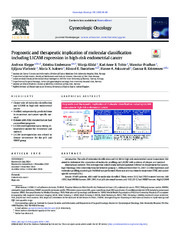| dc.contributor.author | Kleppe, Andreas | |
| dc.contributor.author | Lindemann, Kristina Yvonne Kathe | |
| dc.contributor.author | Kildal, Wanja | |
| dc.contributor.author | Tobin, Kari Anne Risan | |
| dc.contributor.author | Pradhan, Manohar | |
| dc.contributor.author | Vlatkovic, Ljiljana | |
| dc.contributor.author | Isaksen, Maria | |
| dc.contributor.author | Danielsen, Håvard Emil Greger | |
| dc.contributor.author | Askautrud, Hanne Arenberg | |
| dc.contributor.author | Kristensen, Gunnar S Balle | |
| dc.date.accessioned | 2025-02-20T09:44:17Z | |
| dc.date.available | 2025-02-20T09:44:17Z | |
| dc.date.issued | 2024-11-16 | |
| dc.description.abstract | Introduction. The role of molecular classification and L1CAM in high-risk endometrial cancer is uncertain. We aimed to determine the association of molecular profiling and L1CAM with patterns of relapse and survival.<p> <p>Material and methods. This retrospective cohort study included patients referred to Department for Gynecologic Oncology, Oslo University Hospital between January 1, 2006 and December 31, 2017. L1CAM expression and molecular profiling according to ProMisE was performed. Main outcome was time to recurrence (TTR) and cancer specific survival (CSS). <p>Results. Of 489 patients, 486 could be molecular classified. Thirty-seven (8 %) had POLE mutated tumors, 148 (30 %) had MMRd tumors, 189 (39 %) had p53 abnormal tumors, and 112 (23 %) had NSMP tumors. High L1CAM expression was observed in 256 (53 %), low in 227 (46 %) tumors (6 (1 %) missing). ProMisE was significant for TTR but not for CSS in multivariable analysis. L1CAM was significant in multivariable analysis for both TTR and CSS. In a multivariable model with ProMisE and L1CAM expression in the same multivariable model, ProMisE lost significance while L1CAM remained significant. Patients with POLE mutated tumors entailed an excellent prognosis while patients with p53 abnormal or L1CAM overexpressing tumors entailed a poor prognosis with a high frequency of distant recurrences. Patients with MMRd tumors, NSMP and p53 abnormal tumors with low L1CAM had an intermediate prognosis. <p>Conclusions. L1CAM is an additional adverse factor in the p53 abnormal and NSMP groups. These groups need special attention in studies intensifying adjuvant treatment. | en_US |
| dc.identifier.citation | Kleppe A, Lindemann K, Kildal W, Tobin KAR, Pradhan M, Vlatkovic L, Isaksen M, Danielsen HE, Askautrud HA, Kristensen GSB. Prognostic and therapeutic implication of molecular classification including L1CAM expression in high-risk endometrial cancer. Gynecologic Oncology. 2024 | en_US |
| dc.identifier.cristinID | FRIDAID 2360157 | |
| dc.identifier.doi | 10.1016/j.ygyno.2024.11.005 | |
| dc.identifier.issn | 0090-8258 | |
| dc.identifier.issn | 1095-6859 | |
| dc.identifier.uri | https://hdl.handle.net/10037/36536 | |
| dc.language.iso | eng | en_US |
| dc.publisher | Elsevier | en_US |
| dc.relation.journal | Gynecologic Oncology | |
| dc.rights.accessRights | openAccess | en_US |
| dc.rights.holder | Copyright 2024 The Author(s) | en_US |
| dc.rights.uri | https://creativecommons.org/licenses/by/4.0 | en_US |
| dc.rights | Attribution 4.0 International (CC BY 4.0) | en_US |
| dc.title | Prognostic and therapeutic implication of molecular classification including L1CAM expression in high-risk endometrial cancer | en_US |
| dc.type.version | publishedVersion | en_US |
| dc.type | Journal article | en_US |
| dc.type | Tidsskriftartikkel | en_US |
| dc.type | Peer reviewed | en_US |


 English
English norsk
norsk
